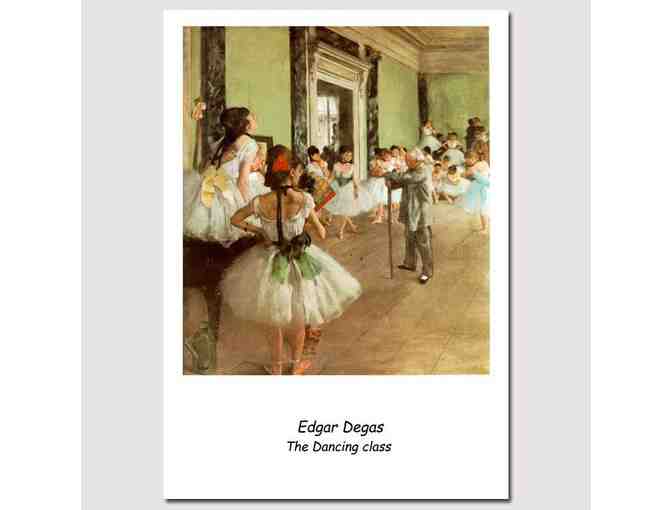EXTREME BARGAINS!
"The Dancing Class" by Edgar Degas
- Item Number
- 1856
- Estimated Value
- Priceless
- Opening Bid
- 15 USD
Item Description
Details of this item
"The Dancing Class" by Edgar Degas
Master Artist Museum Print
Size: 11.7" x 16.5"
Status: Unframed
About the Artist
Hilaire German Edgar Degas was born on July 19, 1834, in Paris, France, the son of a well-to-do banker. From an early age Edgar loved books, especially the classics, and was a serious student in high school. He was very attached to his younger brother, Rene, and he would later paint his image repeatedly. He was also fond of his mother, and her death when he was thirteen years old caused him much heartache. His father hoped Edgar would study law, but Edgar enrolled at the ecole des Beaux-Arts (School of Fine Arts) in 1855. Degas always valued this early classical training. He had a great and enduring admiration for Ingres (1780–1867), a painter with a decisively linear orientation (characterized by a reliance on simple lines and brushstrokes).
In 1856 Degas went to Italy and settled in Rome for three years. He admired the early Christian and medieval masterpieces of Italy, as well as the frescoes (paintings done on fresh plaster), panel paintings, and drawings of the Renaissance (a period in Italy from roughly the fourteenth century until the seventeenth century that was marked by a renewed interest in the arts) masters. He copied many of these. At that time this was a common way of studying art.
Back in Paris in 1861, Degas executed a few history paintings (a painting that depicts a historical event; then regarded as the highest branch of painting). Among these was the Daughter of Jephthah (1861), which is based on an episode from the Old Testament in the Bible. He copied the works of the old masters (the well-regarded painters of the Renaissance) in the Louvre. His reputation as a painter had already been established prior to the 1870s.
From 1862 until 1870 Degas painted portraits of his friends and family. In 1870, during the Franco-Prussian War (a conflict between France and the German state of Prussia), he served in the artillery (the part of the army that deals with weaponry) of the national guard. Degas stopped exhibiting at the respected Salon in 1874 and instead displayed his works with those of the less well-established impressionists until 1886. Although he was associated with the impressionists, his preoccupation with drawing and composition was not characteristic of the group.
Degas, who believed that "the artist must live alone, and his private life must remain unknown", lived an outwardly uneventful life. In company he was known for his wit, which could often be cruel. He was characterized as an "old curmudgeon" by the novelist George Moore, and he deliberately cultivated his reputation as a misanthropic bachelor. Profoundly conservative in his political opinions, he opposed all social reforms and found little to admire in such technological advances as the telephone. He fired a model upon learning she was Protestant.
Although Degas painted a number of Jewish subjects from 1865 to 1870, his anti-Semitism became apparent by the mid 1870s. His 1879 painting At The Bourse is widely regarded as strongly anti-Semitic, with the facial features of the banker taken directly from the anti-Semitic cartoons rampant in Paris at the time.
The Dreyfus Affair, which divided Paris from the 1890s to the early 1900s, further intensified his anti-Semitism. By the mid 1890s, he had broken off relations with all of his Jewish friends, publicly disavowed his previous friendships with Jewish artists, and refused to use models who he believed might be Jewish. He remained an outspoken anti-Semite and member of the anti-Semitic "Anti-Dreyfusards" until his death on 27th September 1917 in Paris, France.
Item Special Note
PLEASE TAKE A FEW MOMENTS TO VISIT OUR AUCTION HOME PAGE! Click here to see hundreds and hundreds of awesome offerings ON AUCTION NOW!
* INSURED FEDERAL EXPRESS SHIPPING: $59.95
* BIDDING FOR GOOD "PERFORMANCE FEE": 9%
* CREDIT CARD PROCESSING FEE: 4%
NOTE!! The "GOOD NEWS":
USE THE BUY NOW OPTION AND YOU CAN CHOOSE UP TO FOUR A3 PRINTS IN THIS SEGMENT AND PAY ONLY ONE SHIPPING FEE OF $39.99
* In accordance with California State Law, SALES TAX APPLICABLE ONLY FOR CALIFORNIA RESIDENTS
ART+more4Good stores data...
Your support matters, so ART+more4Good would like to use your information to keep in touch about things that may matter to you. If you choose to hear from ART+more4Good, we may contact you in the future about our ongoing efforts.
Your privacy is important to us, so ART+more4Good will keep your personal data secure and ART+more4Good will not use it for marketing communications which you have not agreed to receive. At any time, you may withdraw consent by emailing Privacy@frontstream.com or by contacting our Privacy Officer. Please see our Privacy Policy found here PrivacyPolicy.





